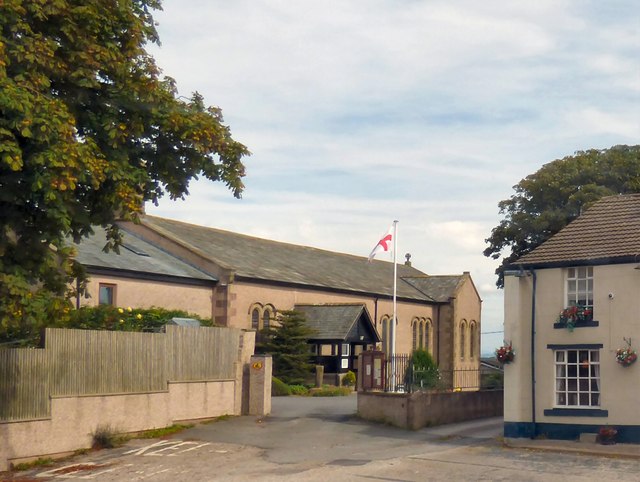Bailiwick of Stalmine
(an unusual feudal Lordship of the Manor)

St. James Church in Stalmine, Lancashire
Welcome to our Webpage!
History
This unusual feudal Lordship lies in the township of Stalmine within the extensive parish of Lancaster. Stalmine lies
in the part of West Lancashire known as Fylde. It derives its name from the Old English and Norse for a pool or stream
at the mouth of the river, steall mynni. It is situated a few miles north of Blackpool, on the banks of the river Wyre.
The village history dates back to 1066 when Stalmine was listed in the Domesday Book, located in the hundred
of Amounderness and the county of Yorkshire. Tostig Godwinson (c. 1029 - 25 September 1066) was Anglo-Saxon
and Earl of Northumbria as brother of King Harold Godwinson. After being exiled by his brother, Tostig supported
the Norwegian king Harald Hardrada's invasion of England, and was killed alongside Hardrada at the Battle of Stamford
Bridge in 1066. The Bailiwick and all other lands and manors than passed to Roger of Poitou.
Although called a Bailiwick it was, in effect, a lordship of the manor and descended as such a property would. The
Bailiwick is sometimes described as a sub-manor of the extensive Lordship of Furness and was under the control of a
bailiff appointed by the Lords of Furness, the monks of Furness Abbey.
The monks of Furness Abbey held land in Stalmine since the 12th century. Founded in 1127 by Stephen, Count of Boulogne
(later King Stephen) and Mortain, Lord of Lancaster, the monks of Furness were granted lands by a number of large
landowners including land in Stalmine. The first recorded possessor was Robert de Stalmine in 1165. Around 1200
he granted the monks a carucate land called
Corocola from his estate and this formed the basis of the subsequent Bailiwick. In 1240 William's son John granted more
of the family estate in the township to the abbey, as did his brother, Herny. Grants were made throughout the 13th century
and the monks became primary landlords. In 1318 for instance, an agreement was made between the abbey and Nicholas de Oxley
who was seeking to improve five acres of waste. The monks insisted that they will be allowed to continue to drive their
cattles over his land to the common. At the same time de Oxley released his claim to a water mill which they had constructed
near to their demesne farm, known as The Grange.
According to the antiquarian Francis Gastrell "in the course of time the Abbey of Furness obtained the whole manor, which
fell to the King at the Dissolution." The Abbey of Furness was dissoved in 1536 and its lands and estates were seized by
the Crown. This meant that the succeeding Kings and Queens of England, from Herny VIII to Charles II, were Lords of the
Bailiwick.
A survey of the manor of Furness, made in 1649, notes that; "There is a rent due from divers tenements in the Bailiwick of
Stalmyne, which is right due and belonging to manor of Furness, as part of the said manor and payable to the receiver-general
of the county of Lancaster and is per annum £10 2s 10d. Memorandum - the Bailiwick of Stalmyne is about then miles from
Lancaster and about thirty miles from the Manor of Furness."
In 1666, as a reward for his help in restoring the Stuart Dynasty to the throne, the Lordship of Furness and the abbey estates,
including Stalmine, were granted to the Duke of Albermarle.
The Duke remained a loyal officer of the King Army and Navy until his death in 1670 when his title and estates passed to his
son Christopher who died childless in 1687. Stalmine passed, with the rest of his possessions, to his wife who survived to the
age of 95, dying in 1734. From her it passed to her second husband, Ralph, 1st Duke of Montagu. He was succeeded by his son
John, 2nd Duke of Montagu who had no sons and passed his estates to his daughter Isabelle, wife of Edward Hussey, Earl of
Beaulieu. In 1801 an inquiry was made into the estate of Edward, Earl of Beulieu, who was declared a lunatic. The Bailiwick
of Stalmine was listed as one of his possession.
The Bailiwick passed to Mary who married George Brudenell, 4th Earl of Cardigan (great-grandfather of Cardigan of the
Charge of the Light Brigade). The Bailiwick of Stalmine consequently passed to Mary's daughter, Lady Elizabeth Montagu who was
married to the 3rd Duke of Buccleuch. The Bailiwick then remained in the hands of the Dukes of Buccleuch. In 1835, Francis
Duke of Beccleuch sold a huge part of his Lancashire Estate to Peregine Towneley for £90,000, an astonishing amount at that
time This conveyance included the Bailiwick of Stalmine and the various rents which issued from it, which totalled to
£10 10s 1d a year. Rents were collected in Stalmine for Towneley in 1846.
Finally the Towneley Estates eventually passed to the Barons O'Hagan and the Bailiwick was sold to Mrs. Rosemary
Blaikie from Blackpool at the beginning of the century. In 2022 the Lordship and Bailiwick of Stalmine was sold to the present
holder of the Lordship of the Manor.
You can contact us by E-mail info@stalmine.org.uk

